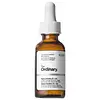What's inside
What's inside
 Key Ingredients
Key Ingredients

 Benefits
Benefits

 Concerns
Concerns

No concerns
 Ingredients Side-by-side
Ingredients Side-by-side

Water
Skin ConditioningArbutin
AntioxidantPropylene Glycol
HumectantGlycerin
HumectantSodium PCA
HumectantHyaluronic Acid
HumectantSaccharide Isomerate
HumectantPanthenol
Skin ConditioningSalvia Officinalis Leaf Extract
CleansingVitis Vinifera Seed Extract
AntimicrobialRosa Canina Bud Extract
Skin ConditioningAllantoin
Skin ConditioningHypericum Perforatum Flower Extract
Skin ConditioningCitric Acid
BufferingNiacinamide
SmoothingSodium Citrate
BufferingHydroxyethylcellulose
Emulsion StabilisingPhenoxyethanol
PreservativeEthylhexylglycerin
Skin ConditioningPolysorbate 20
EmulsifyingTriethanolamine
BufferingWater, Arbutin, Propylene Glycol, Glycerin, Sodium PCA, Hyaluronic Acid, Saccharide Isomerate, Panthenol, Salvia Officinalis Leaf Extract, Vitis Vinifera Seed Extract, Rosa Canina Bud Extract, Allantoin, Hypericum Perforatum Flower Extract, Citric Acid, Niacinamide, Sodium Citrate, Hydroxyethylcellulose, Phenoxyethanol, Ethylhexylglycerin, Polysorbate 20, Triethanolamine
 Reviews
Reviews

Ingredients Explained
These ingredients are found in both products.
Ingredients higher up in an ingredient list are typically present in a larger amount.
Phenoxyethanol is a preservative that has germicide, antimicrobial, and aromatic properties. Studies show that phenoxyethanol can prevent microbial growth. By itself, it has a scent that is similar to that of a rose.
It's often used in formulations along with Caprylyl Glycol to preserve the shelf life of products.
Water. It's the most common cosmetic ingredient of all. You'll usually see it at the top of ingredient lists, meaning that it makes up the largest part of the product.
So why is it so popular? Water most often acts as a solvent - this means that it helps dissolve other ingredients into the formulation.
You'll also recognize water as that liquid we all need to stay alive. If you see this, drink a glass of water. Stay hydrated!
Learn more about Water